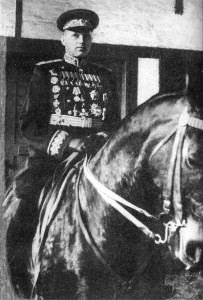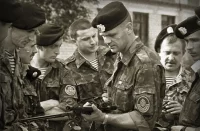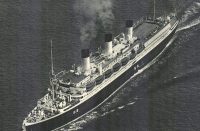In this time period which started in 1930 with wooden plow shares to winning the war in Europe almost single handedly to a cache of nuclear weapons in 1955. How did all this happen? In the 1950’s if one were to suggest that the Soviet Union would produce more iron and oil then the U.S., you were considered silly. If you suggested that the Soviet Union would have parity with the U.S. in nuclear weapons you were considered a traitor. Yet both of these events came to be in the 1970’s. In 1949 Professor Bush who was president of MIT and chief scientist of the U.S. wrote a book in which he stated that the atomic bomb was so complex that the Russians would never be able to develop the weapon but if they were lucky they might develop one in 20 years. The book was printed and scheduled to be released. BUT, the Russians exploded their first atomic bomb two days before the scheduled release of the book. It was never released. The first hydrogen bomb was detonated by the Russians in 1961 . SPUTNIK was launched in 1957. First object in SPACE !!!One needs to examine this quarter century as to what happened and the results. When I mention ethnicity this by no means reflects on the vast majority of that particular group.
First, let’s take a short step back into the 1920’s and check in on Boris Savinkov. He was the Jewish leader of the Social Revolutionaries which were Jewish in the main. He gave Fanny Kaplan the revolver with which to shoot Lenin which she did. Lenin died a few years later . Boris fled to the U.S. where he remained until Felix Dzerzhinsky (Stalin’s chief of secret service who was a Polish nobleman by birth) lured him back to the Soviet Union and had him and his cohorts executed in the mid 1920’s. Boris wrote a book titled “Memoirs of a Terrorist” published by Albert & Charles Boni ( DK 254.S28 A3) in which he wrote about his intent to assassinate the Russian generals and admirals who fought in the Russo-Japanese war of 1904-1905 and key governmental officials. Boris Savinkov had something to do with the Purges in the late 1930’s. Boris admitted that he was a terrorist and wrote a book about being a terrorist.
Two main events took place in the 1930’s namely collectivization/famine in the 1932/1933 era and the purges in the late 1930’s. The purges are the result of attempts to undo the Soviet government.
Let’s start with the Purges or in Russian the chistka , translated as “cleansing”. Did the Soviet Union have internal and external enemies? Of course they did. With war on the horizon they had to address the problem. Did they make mistakes ? YES. Was there a 5th column (collaborators) in the Soviet Union when the Germans invaded in 1941? NO. But the Germans had 5th column collaborators welcoming them in all the other countries they invaded. Fascism and anti-Semitism had supporters through out much of Europe. The Catholic church had concordats (church/state agreements) with Nazi Germany and the other fascist countries in Europe. In 1941 Joseph E. Davis ,former American Ambassador to the Soviet Union wrote :” There were no 5th columns in Russia in 1941—they had all been shot. The purge had cleansed the country and rid it of treason. The Axis 5th column in the Soviet Union had been smashed”. So the purges were both good and effective. Again, some innocents were shot. But 10’s of millions of innocents were killed during World War II. We need to quantify those who were purged. The vast majority of those executed were Jews, Poles, and non-Slavic citizens of the Soviet Union. Communist party members were frequently shot. Why? Because they were not trusted and showed hostility to the Soviet Government. One criteria for being shot was that of “ if you were in a position of authority and your loyalty was in doubt, you were shot”. Why Poles? During the early 1930’s they held secret agreements with the Japanese to attack the Soviet Union. Japan attacked Manchuria in 1931. The every day rank and file of the Russian/Ukrainian populations were virtually unaffected by the purges. Something like 1 in 10,000 were affected. Well over 90% of the hundreds of thousands executed fall into the categories noted. Of those award Hero of the Soviet Union during WWII there were 108 Jews. The fifth most after the Russians, Ukrainians, Byelorussians and Tatars. 11,633 Hero of the Soviet Union medals were awarded to an army that exceeded 10,000,000 during the course of the war. Marshall Chernyakhovsky who was Jewish, commanded the 3rd Byelorussian Front in the final year of WWII & was killed in action. The Poles had 6 divisions as part of the Red Army in the Battle of Berlin. Of the ethnic groups, some were heroes , some were traitors and the big majority just ordinary folks. Interesting, Andrei Vyshynsky (who was the primary judge during the purge era) was Polish.

Marshall Konstantine Rokossovsky was of mixed Russian/Polish birth. A book titled “The Great Conspiracy “ by Michael Sayers & Albert Kahn published by Little, Brown & Company in 1946 provides insight into the purges. Leon Trotsky and his supporters were purged very heavily. Origins of the Great Purges by J. Arch Getty published in 1987 by Cambridge University Press provides additional insights as does Robert W. Thurston’s book “Life and Terror in Stalin’s Russia “ published in 1996 by Yale University Press. Of the five million sent to prisons/gulags, 95% came out alive. This figure includes a number of generals that went on to fight and win WWII with the Red Army.
Collectivization and famine of 1932/33 is a more complex topic. In 1930 the Soviet government estimated that war would come in 10 years. That was a good estimate in that the Soviet Union was invaded in June,1941. They had to build up a war industry which they did. Where was the labor to come from ? A very big % of the population was employed in agriculture. Using a horse and wooden plow and tilling a small plot of land was not efficient. Collectivizing the farms and using tractors and steel plows was much more efficient and resulted in freeing up the surplus labor to establish war industries. The rich landlords called kulaks were about 1 % of the agricultural population and not happy about collectivization. The country had to prepare for the war that was coming. All one has to do is read Hitler’s Mein Kampf which was a best seller to see what Germany’s intentions were. WAR. A critical issue was the famine of 1932/33. What were the causes? Who was responsible? How many people died in the famine? There was a severe drought in 1932 which reduced the harvest. There was a lot of chaos and sabotage during this period resulting in killing of live stock and general disruption of collectivization. Kulaks did not want collectivization. Interesting, late Soviet leaders such as Gorbachev and Yeltsin were offspring of kulaks. The NKVD ( Peoples Committee of Internal Affairs, secret police) were held responsible for some of the chaos. The NKVD at that time was about 50% Jewish with a large number of other national minorities. The % of Jews in the NKVD was reduced to 4% when the purges were completed in late 1939.The Russians/Ukrainians were a minority in the Soviet secret police in the early 1930’s. That changed late in the 1930’s when the big majority of NKVD agents were Russian. The bad drought and the mismanagement / sabotage were responsible for the famine that followed. Kosior who was the head of the Communist party in the Ukraine at the time was executed in 1939. He was a Polish Jew. He was held responsible for the famine. Ukrainians and Jews have been in some level of conflict since the mid 1600’s to the start of the pogroms in 1881 and beyond. Cause of the famine has many aspects starting with a drought and followed by mishandling whether deliberate or ineptness. The famine and who promoted the extent of the famine needs to be examined. The Hearst newspaper was big on raising the massiveness of the famine. With the stock market crash in the U.S. in 1929 and the resulting 10 year Depression, there had to be something very bad about socialism to balance the badness of the Depression. Before we explore the extent of the famine 2 facts have to be revealed . First, the Ukrainian population grew by 3,340,000 from 1928 to 1939 . About a 10% increase. Second, during WWII the Ukrainians were awarded Hero of the Soviet Union in the same percentage that they were in the population of the Soviet Union. They fought with the same intensity as the Russians. Estimates of the famine depending upon the author vary from 10 million to 6 million to 3 million. Two out of these 3 estimates and more probably all of them are wrong. Given the 2 facts noted above, these estimates have to be regarded as exaggerations. My own personal discussion’s with people from the Ukraine who were adults during the 1930’s gives no indication of a massive famine. Times were tough but people survived.
Douglas Tottle’s, book “Fraud Famine and Fascism the Ukrainian Genocide Myth” published in 1987 by Progressive Books ,71 Bathurst St. in Toronto, Canada provides a reasonable perspective about the famine in the Ukraine in 1932/33. A Mennonite historian ( Mennonites have no axe to grind) estimates that those who died in the famine were less then 1% of the population or about several hundred thousand. NOT in the millions. There are no cemetery’s in the Ukraine to suggest that 10% or more of the population died in the 1932/33 time period. Sorrow and Eternal Memory to those who perished. In 1932, 80%, of British machinery exports were to the Soviet Union. The Soviet Union had to industrialize and build a war industry, which they did. The British were demanding payment in wheat rather gold ,oil or timber. The wheat was confiscated to repay the debt for industrial machinery. The entire process was mishandled and peasant populations suffered . In 1934 no wheat was allowed to be exported from the Soviet Union. There was no starvation in Soviet cities. It was not a deliberate attempt to punish the Ukrainian people as some try to claim. It was a series of bad decisions in which peasants throughout the Ukraine and southern Russia suffered. The extent of the people who perished in the famine will not be known exactly. If it were as massive as some historians try to claim then there would be 10’ and 100’s of thousands of personal notes that people would have written. These notes are not there. (READ MORE: Episode 10. Who Organised the Famine in the USSR in 1932-1933? -OR)
The Jewish tragedy in Europe needs to be quantified. During the Holocaust, the Nazi’s killed more Jews in ONE DAY then the Russian Tsar was held accountable for killing in FIVE CENTURIES of Tsarist rule. This figure is from a noted historian. Japan attacked Russia in 1904. Jews refused to serve in the Russian army to defend Russia. The so called pogroms took place starting in 1881 and lasting 30 plus years until the start of WWI in 1914. The 1881 incident took place in Kiev in which 3 Jews were killed along with 3 Christians. A simple street brawl. The worse incident took place in Kishinev Moldavia during Easter time in 1903 in which up to 100 Jews were killed. The supposed cause was the ridiculous charge of blood libel in which the Jews used Christian blood in their matzos. It is equally ridiculous to suggest that Christians use snakes in their religious services. But there continue to be backwoods Christians who do use snakes in their churches and there could have been whacky Jews involved in blood libel. All told about 600 Jews were killed during this 30 plus year period. A disproportionate number were killed in Moldavia. Similar killings took place in America during this time period. Lynching’s, vigilante killings and people taking the law into their hands was not uncommon. The Jews who survived WWII in Europe have the Red Army to thank.
One reads a lot about Katyn and the killing of 4500 Polish officers. At the onset of WWII in September,1939 the Russians captured 400,000 Polish soldiers. Approximately 5% of that army consisting of reserve officers were subjected to harsh treatment and were killed. Over 95 % of that Polish army continued to fight against the Nazi’s as part of the Red Army and some fought in Italy. The reserve officers were not regular army officers. In civilian life, they were public officials, police officers, government employees, lawyers and other professional types. After WWI the Curzon Line was established that accurately divided the boundary between Polish and Ukrainian populations. During the Russian Revolution, the Poles under Marshall Pilsudski attacked, moved about 130 miles eastward and enslaved 5,000,000 Ukrainians. Between 1920 and 1939 when western Ukraine ( about 5,000,000) was under Polish rule there was much turmoil between the Poles and Ukrainians to the point that the Ukrainians killed the Polish Interior Minister and numerous Polish officials. Poland was a fascist military dictatorship during this period. The repression inflicted upon the Ukrainians in the 1920 to 1939 period had to be corrected . The reserve officers were imprisoned. They were told to change their attitudes about governing the western Ukraine. Those executed at Katyn (4421, included both Jews and Poles) scoffed at attempts to change their attitudes. They hated and were sworn enemies of the Soviet system and were killed. War was on the way and anything short of absolute compliance was regarded as treason. Poland lost 5,500,000 people during the war. 3,000,000 Jews and 2,500,000 Poles. They were killed by the Germans. The Germans killed at least 300 times as many Polish citizens as did the Russians. And had the Russians not liberated Poland from the Nazi’s the entire Polish population was scheduled for annihilation and there would not be a Poland today. No one talks of what happened to the 100’s of thousands of Polish soldiers captured by the Germans. Why not? (Soviet responsibility for the Katyn tragedy is still questioned by a number of historians. – OR)
ORIENTAL REVIEW thanks Mr.Dublanica for his kind submission.
PREVIOUS EPISODES
Episode 10. Who Organised the Famine in the USSR in 1932-1933?
Episode 9. How the British “Liberated” Greece
Episode 7. Britain and France Planned to Assault Soviet Union in 1940
Episode 6. Leon Trotsky, Father of German Nazism
Episode 5. Who paid for World War II?
Episode 4. Who ignited First World War?
Episode 3. Assassination in Sarajevo














Pingback: Episode 12. Why did Britain and the United States have no desire to prevent WWII? (I) | Oriental Review
Covering a number of issues, the above article is a thought provoking piece, that leads to several follow-up points.
Pingback: Episode 15. Poland Betrayed (I) | Oriental Review
Pingback: Episode 15. Poland Betrayed (IV) | Oriental Review
Pingback: Episode 17. Britain – Adolf Hitler’s star-crossed love (I) | Oriental Review
Pingback: Episode 17. Britain – Adolf Hitler’s star-crossed love (II) – OrientalReview.org
Pingback: Episode 20. Who put up the Berlin Wall? | OrientalReview.org
Pingback: L’Europe d’une guerre à l’autre (XI) – Un quart de siècle soviétique (1930-1955) | Réseau International
Pingback: L’Europe d’une guerre à l’autre (XII – 1) – Pourquoi la Grande-Bretagne et les États-Unis n’avaient-ils aucune envie d’empêcher la Seconde Guerre Mondiale? | Réseau International
Pingback: L’Europe d’une guerre à l’autre (XII – 2) – Pourquoi la Grande-Bretagne et les États-Unis n’avaient-ils aucune envie d’empêcher la Seconde Guerre Mondiale? | Réseau International
Pingback: L’Europe d’une guerre à l’autre (XII – 3) – Pourquoi la Grande-Bretagne et les États-Unis n’avaient-ils aucune envie d’empêcher la Seconde Guerre mondiale? | Réseau International
Pingback: L’Europe d’une guerre à l’autre (XII – 4) – Pourquoi la Grande-Bretagne et les États-Unis n’avaient-ils aucune envie d’empêcher la Seconde Guerre Mondiale? | Réseau International
Pingback: L’Europe d’une guerre à l’autre (XIII – 1) – Pourquoi Londres a-t-il donné Vienne et Prague à Hitler ? | Réseau International
Pingback: L’Europe d’une guerre à l’autre (XIII – 2) – Pourquoi Londres a-t-il donné Vienne et Prague à Hitler ? | Réseau International
Pingback: L’Europe d’une guerre à l’autre (XIII – 3) – Pourquoi Londres a-t-il donné Vienne et Prague à Hitler ? | Réseau International
Pingback: L’Europe d’une guerre à l’autre (XIV – 1) – Comment Adolf Hitler est devenu un « agresseur provocateur » | Réseau International
Pingback: L’Europe d’une guerre à l’autre (XIV – 2) – Comment Adolf Hitler est devenu un « agresseur provocateur » | Réseau International
Pingback: L’Europe d’une guerre à l’autre (XIV – 3) – Comment Adolf Hitler est devenu un « agresseur provocateur » | Réseau International
Pingback: L’Europe d’une guerre à l’autre (XV – 1) – La Pologne trahie | Réseau International
Pingback: L’Europe d’une guerre à l’autre (XV – 3) – La Pologne trahie | Réseau International
Pingback: L’Europe d’une guerre à l’autre (XVIII– 1) – Comment la Grande-Bretagne a aidé l’Union Soviétique à combattre Hitler | Réseau International
Pingback: L’Europe d’une guerre à l’autre (XVIII– 2) – Comment la Grande-Bretagne a aidé l’Union Soviétique à combattre Hitler | Réseau International
Pingback: L’Europe d’une guerre à l’autre (XVIII– 3) – Comment la Grande-Bretagne a aidé l’Union Soviétique à combattre Hitler | Réseau International
Pingback: L’Europe d’une guerre à l’autre (XX) – Qui a posé le mur de Berlin? | Réseau International
Pingback: History of World War II: Adolf Hitler Was Not Planning to Go to War against Britain and France? – Niki´s Opinion Forum